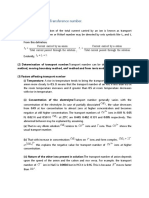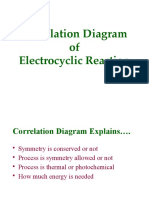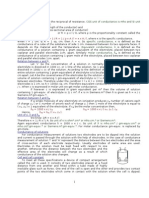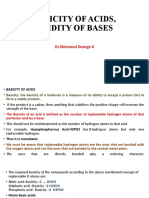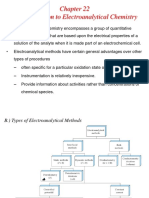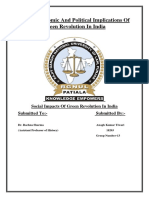7
7
Uploaded by
Shibu KumardCopyright:
Available Formats
7
7
Uploaded by
Shibu KumardCopyright
Available Formats
Share this document
Did you find this document useful?
Is this content inappropriate?
Copyright:
Available Formats
7
7
Uploaded by
Shibu KumardCopyright:
Available Formats
THERMODYNAMICS OF BIOPOLYMER SOLUTIONS 181
181
7.1 INTRODUCTION AND GENERAL
PRINCIPLES
Low molecular weight substances can readily undergo
dissolution, however, biopolymers take considerable time to
do so. At fairly low concentrations, polymer solutions are
highly viscous while low molecular weight substances are far
less viscous even at high concentrations. In the case of low
molecular weight solutes the individual molecules (mostly the
ions) are discrete and separate from one another which are
held together within the solid matrix by van der Waals or
electrostatic forces of attraction. When such a solute and a
solvent solute are brought together, the solvent molecules
surround the solute molecules at the surfaces to establish
solvent-solute interaction and break the solute-solute
attraction. Consequently the solute molecules (which are
discrete) are isolated from the solid phase. Since their size is
comparable to that of the solvent molecules, they diffuse fast
into the solvent phase and the dissolution process is thus
fast.
Biopolymers, however, are very large molecules as
compared to the solvent molecules. These are made up of
tightly folded random coils. These molecular coils also do not
represent discrete and separate entities but are
interpenetrating and entangled with one another. There are
also varying degrees of cohesive and attractive forces between
different segments of the same molecular coil as well as
neighbouring coils. Thus, solvent molecules take time to
establish interactions with polymer molecules, to overcome
the forces of attraction, to release individual molecules out of
7 7
7 77
C H A P T E R
THERMODYNAMICS OF
BIOPOLYMER SOLUTIONS
182 BIOPHYSICAL CHEMISTRY
When a polymer fragment
interacts with a solvent, forces
of attraction or dispersion
start acting between them.
When the solvent-solute
interaction becomes more
powerful than the solute-
solute attraction, the forces
holding the polymer segments
together are weakened and
the solvent molecules force
their way between the
segments. The overall process
thus leads to the solvation of
segments. Overall this is a
slow process.
the chain entanglement and get them out of the polymer
phase. This is the difference in the dissolution process of low
and high molecular weight substances.
7.2 THERMODYNAMICS OF BIOPOLYMER
SOLUTIONS
Thermodynamic principles which govern the dissolution of
low molecular weight solutes and biopolymers (high molecular
weight-solutes) are the same. A change of state of a system
from e.g., solid to solution in Thermodynamic terms is related
to changes in the entropy ( S) and the enthalpy ( H) of the
system. The following points may be noted:
Any given system tries to shift in the direction of a
state in which the enthalpy or the heat content (H) is
minimum, and/or the entropy or degree of disorder-
liness or randomness (S) is maximum. A system can
spontaneously shift from one state to another state
provided in the process, there is a loss in the enthalpy
( H) and/or a gain in the entropy (+ S). When the
system changes from one state to another, the
associated entropy and enthalpy changes are
independent of each other. During a change the
enthalpy can increase (+ H), decrease ( H) or
remain unchanged ( H = 0). Moreover, during the
same process, there can be either an increase or a
decrease in the entropy factor.
If during a process, there is a decrease in the enthalpy
with a simultaneous increase in the entropy ( H
and + S), both of them support the change of state
and the process is spontaneous.
When there is an increase in the enthalpy along with
a decrease in the entropy (+ H and S), both the
parameters are unfavourable and the change of state
(e.g., solid to solution) does not occur.
In a situation when both the entropy as well as
enthalpy either increase or decrease i.e., one entity
supports the process, while the other opposes it, the
feasibility of such a process then depends on the sign
of the Gibbs free energy change ( G), which is a
manifestation of two different entities ( H) and ( S)
as show in (Scheme 7.1).
THERMODYNAMICS OF BIOPOLYMER SOLUTIONS 183
G = H T S
SCHEME 7.1
This concept of Gibbs free energy change is central to
different energy-related areas in chemical, biochemical and
biological reactions and the relative predominance of the
entities H and S will influence the course of the reaction
e.g., dissolution which is a process being discussed.
(A) DISSOLUTION OF A LOW MOLECULAR WEIGHT SOLUTE
The following points may be considered:
Dissolution of a substance leads to increase in entropy.
(The solute particles become more disordered in the
dissolved state compared to that in the bound state of
the solute). Thus the only other parameter which will
decide the feasibility of the process of dissolution is
change in enthalpy.
When there is decrease in enthalpy ( H) i.e., the
dissolution process is exothermic, the resultant free
energy change (G) becomes negative and dissolution
becomes a spontaneous process (Scheme 7.1).
The process of dissolution also becomes spontaneous
when the process is neither exothermic nor
endothermic. The entropy gain alone is then sufficient
to bring about a decrease in the free energy of the
system.
With an increase in enthalpy (+ H), the dissolution
process is endothermic. In this case, the process of
dissolution will be opposed by the + H factor, while
it will be favoured by the + S, and the process is
feasible as long as + H is less than TS. When
+ H becomes equal to or greater than TS, the
dissolution process cannot take place.
When the dissolution process is exothermic, the solute
is soluble in the solvent in all proportions.
During an endothermic dissolution, in the initial stages
of the dissolution process (the + H value) is less
than the TS value and that is why dissolution occurs
in the first place. With the progress of the dissolution
process, the entropy gain (TS) progressively decreases
because the concentration of the solute phase is
decreasing while that of the solution phase is
Under the usual conditions of
constant temperature and
pressure, the thermodynamic
condition to form a two-
component solution is that
the Gibbs free energy G
12
of
the mixture must be less than
the sum of the Gibbs free
energies G
1
and G
2
of the
pure individual components.
This requirement is defined in
terms of the Gibbs free energy
of mixing.
G
m
= G
12
(G
1
+ G
2
) which
must be negative (i.e., G
m
<
0) for the formation of a
solution. Gibbs free energy is
related to enthalpy H and
entropy S by the standard
thermodynamic equation,
therefore, a useful relation for
G
m
is (G
m
= H
m
TS
m
).
184 BIOPHYSICAL CHEMISTRY
increasing. When the TS value decreases and becomes
equal to + H, G = 0, consequently no further
dissolution is possible. At this stage an equilibrium is
established between the gain both in entropy as well
as enthalpy. The number of solute molecules going
into solution equals those precipitating out. The
solution at this point of equilibrium is called
saturated.
(B) DISSOLUTION OF A MACROMOLECULE
The thermodynamic principles regarding dissolution of
macromolecules are the same. The following points may be
noted:
When strong attraction forces operate between the
polymer segments and solvent molecules, the heat of
dissolution becomes negative ( H), and this makes
the process of dissolution favourable. The
macromolecule is then completely soluble in the solvent
in all proportions.
When these strong forces are absent, and only weak
dispersion forces are operative between the polymer
and the solvent, the H becomes positive. Dissolution
can still occur even when H is positive as long as its
value is less than TS. Fortunately, in the case of
macromolecules also, the magnitude of entropy gain
in the dissolution process is high.
When a macromolecule undergoes changes in its state
from solid to solution, both the molecular mobility as
well as the segmental mobility is generated.
Macromolecules are made up of hundreds of segments
rotating freely around fixed angles (independent of
each other, in a limited sense, at least), they assume
innumerable conformations in the dissolved state. This
freedom of molecular mobility and the segmental
mobility lead to an increase in entropy in the dissolved
polymer. This increased entropy factor can
accommodate + H, leading to negative G, thus
making dissolution possible.
Initially the dissolution process is highly favourable.
With the increase in the concentration of the solution,
the TS value becomes progressively lower as observed
during the dissolution of a low molecular weight-
THERMODYNAMICS OF BIOPOLYMER SOLUTIONS 185
polymer. An equilibrium is finally attained when +
H becomes equal to TS.
In the case of macromolecules the solvation occurs at
random i.e., segment after segment, until all segments
in the molecular coil are fully solvated. The process of
solvation of macromolecules and their subsequent
diffusion into the solvent phase is slow. Since the
polymer molecules are much larger compared to the
solvent molecules, the latter penetrate deep into the
polymer segments and the polymer is in a swollen
state.
In reality, in each polymer molecule some segments
are solvated (unfolded) whereas some others remain
unsolvated (aggregated). There is a constant diffusion
of the solvent molecules between the solvated and the
aggregated segments. Consequently some of the
solvated segments get aggregated, while some of the
aggregated ones are solvated. As a result, a dynamic
equilibrium is set up between the solvated and the
aggregated segments within the swollen mass. As a
result of this polymer molecules do not move out of
the polymer phase and no separate solution phase is
formed.
On adding more quantity of the polymer to this swollen
mass, the solvent molecules start penetrating into the
newly added polymer to make it swell. The attack on
the freshly added polymer sample by the solvent
molecules and the polymer swelling continues till a
fresh equilibrium is attained between the solvated and
the aggregated chain segments. The newly added
polymer therefore, loses its identity and becomes a
part of already existing swollen mass. Thus the volume
of the swollen mass increases. With an increase in the
polymer-to-solvent ratio, the ratio of the aggregated
to the solvated chain segments in the swollen mass
also increases. A saturation point, when the unswollen
solid polymer existing in equilibrium with the solution,
is never attained.
(C) MOLECULAR WEIGHT OF A POLYMER AND DISSOLUTION
The above discussion describes the dissolution of a
monodispersed polymer system. While dealing with a
In a polymer-solvent system
when + H is very high and
exceeds the T S value, the
dissolution cannot take place
and the polymer is not
affected by the solvent.
Dissolution of a biopolymer
is a slow process and involves
two stages. In the first stage,
the solvent molecules
penetrate deep into the
polymer to generate a
swollen gel. In the second
stage, when the strong
polymer-solvent interactions
overweigh the polymer-
polymer intermolecular forces
the swollen gel becomes a
true solution.
186 BIOPHYSICAL CHEMISTRY
polydispersed system (having both low and high molecular
weight components) initially the low molecular weight
components get fully solvated. These diffuse out to give a
solution. The higher molecular weight components are still in
the process of progressive solvation. The following points may
be considered:
When H is negative, the high molecular weight
components also get fully solvated with time and go
into solution. When however, H is positive, the point
of equilibrium may be reached before the high
molecular weight components also get fully solvated.
At the state of equilibrium + H equals TS. Thus
molecules with a molecular weight below a certain
critical value will be in solution and those above it
will be in a swollen state. Such a system, where
equilibrium exists between the solution phase and the
swollen solute phase, is called sol-gel system. The
critical molecular weight value, which is a measure of
the solubility in such an equilibrium system, can be
shifted by using binary solvent mixtures in varying
proportions. Such binary solvent systems usually
comprise a good solvent (with H value) and a poor
solvent or a non-solvent (with + H values). All
components of the polymer sample go into solution in
a good solvent. When a poor solvent is added, due to
its + H factor the equilibrium is shifted in a direction
that some of the segments in the molecular coils of
the highest molecular weight components are brought
into aggregation (they are desolvated) and therefore,
these molecules form the gel phase (the highest
molecular weight fraction of the polymer sample now
precipitates out of the solution phase). By adding more
of the poor solvent, the equilibrium is further shifted
in such a way that the biggest molecules among the
remaining molecules in solution precipitate out. This
principle is involved in the fractional precipitation
method for the separation of a polymer in to different
fractions.
THERMODYNAMICS OF BIOPOLYMER SOLUTIONS 187
7.3 THERMODYNAMIC PRINCIPLES AND
DISSOLUTION OF CRYSTALLINE AND
AMORPHOUS POLYMERS
The crystalline and amorphous polymers differ from each other
in their phase state and are therefore, expected to display
different behaviour during dissolution in a solvent. However,
as far as thermodynamic principles are concerned, these are
true for both these types, i.e., whether H is negative or
positive its magnitude should be less than TS. When it is so
dissolution of polymer whether amorphous or crystalline will
occur. The dissolution of an amorphous polymer is compareable
to mixing of two liquids. Two liquids being of the same phase
state will mix readily provided G of mixing is negative.
Unlike this, the crystalline polymer is in the crystalline phase
state, while the solvent is in the liquid phase state. Since the
two different phases cannot mix to form a single homogeneous
system, mixing or dissolution is impossible unless both of
them are brought into the same phase state. The first step
involved in dissolving a crystalline polymer is thus to bring
it to the liquid phase. A crystalline polymer can be brought
into liquid phase state either by heating to its melting point
or under conditions which lead to cleavage of long range order
present in crystalline state.
The free energy relation governing the solubility of
crystalline polymers near their melting point is in (Scheme
7.2).
G = (H
m
+ H
f
) T (S
m
+ S
f
)
where, m and f = Mixing and fusion, respectively.
SCHEME 7.2
7.4 HEAT OF DISSOLUTION AND THE
SOLUBILITY PARAMETER
As already discussed the amorphous and crystalline polymers
differ in their phase state. Their behaviour is different when
they are dissolved in a solvent. Dissolution of an amorphous
polymer is like the mixing of two liquids, as an amorphous
polymer is considered to exist in the liquid phase state. The
dissolution of a crystalline polymer involves the mixing of
two substances existing in two different phase states (the
crystalline phase polymer, and the liquid phase solvent). The
heat of mixing (H
m
) of two liquids, whose dissolution involves
188 BIOPHYSICAL CHEMISTRY
only dispersion forces (endothermic mixing, is in Scheme (7.3)
given by Hildebrand and Scott).
H
m
= V
m
(
A A | | | |
( | |
| |
(
\ . \ .
2
1/ 2 1/ 2
1 2
1 2
1 2
E E
V V
where, H
m
= heat of mixing
V
m
= total volume of the two liquids
E
1
and E
2
= energy of vaporisation of liquids 1 and 2
V
1
and V
2
= the molar volumes of the two liquids
1
and
2
= volume fractions of liquids 1 and 2.
(E/V) = the amount of energy required to vaporise a unit
volume of the liquid
SCHEME 7.3
During vaporisation, energy is spent to overcome the
cohesive force holding the molecules together and to allow
the molecules completely separate out into the gaseous state.
The term (E/V), refers to a measure of the cohesive force
that holds molecules in the liquid together and is designated
as the cohesive energy density (CED). The term solubility
parameter (), for the square root of the CED is given in
(Eqn. I, Scheme 7.4).
One can now relate the heat of mixing of two liquids
(H
m
) to the solubility parameter of two liquids (Eqn. II,
Scheme 7.4), and the following points may be noted:
=
A | |
|
\ .
1/2
E
V
...(I)
where, = solubility parameter
A
| |
1 2
m
m
H
V
= (
1
2
)
2
...(II)
SCHEME 7.4
The magnitude of the heat of mixing is based on the
square of the difference between the solubility
parameters of two liquids.
For mixing to take place, the positive heat of mixing
is to be at a minimum. This requires the difference
between the solubility parameters (
1
and
2
) to be as
low as possible. When
1
=
2
, then H
m
becomes zero
and mixing will occur readily as a result of entropy factor.
The polymer dissolution can thus be predicted when (Eqn.
II, Scheme 7.4) is simplified to (Eqn. III, Scheme 7.5).
THERMODYNAMICS OF BIOPOLYMER SOLUTIONS 189
H = (
p
s
)
2
p
s
...(III)
where, the subscripts p ands = the polymer and solvent respectively.
SCHEME 7.5
The following predictions may be made from (Eqn. III,
Scheme 7.5).
The polymer will dissolve only in a solvent with
values very close to that of the polymer.
When
p
and
s
values are different, dissolution will
not occur.
The above observations hold good in the case of
amorphous polymers.
The theory does not hold when applied to crystalline
polymers as well as to solvents with strong polar
groups and hydrogen bonding. The solubility parameter
theory is based on dispersion forces and, hence, does
not apply to polymer-solvent systems with positive
interaction where H is negative. Dissolution does
take place in such cases even when
p
and
s
are very
different.
7.5 THE FLORY-HUGGINS THEORY OF
POLYMER SOLUTIONS
The heat of dissolution of a polymer as related to the solubility
parameters of the components has been discussed.
Polymer solutions generally display considerable deviations
from Raoults law, and the law is obeyed only at extreme
dilutions. Apart from deviations at higher concentrations, small
entropies of mixing is another reason. The effect of small
entropies of mixing may be due to large difference in molecular
size between polymer and solvent molecules. The molecular
size difference may be explained by considering the structure
of polymer and polymer solutions based on the quasi-
crystalline lattice model for solutions. An assumption is made
that the molecules of a solution of polymer and solvent can be
arranged in different ways (W). The Boltzmann relation
(Scheme 7.5a) defines W and entropy of mixing.
S
m
= k ln W
where, S
m
= the entropy of mixing
k = the Boltzmann constant.
SCHEME 7.5(a)
Flory-Huggins theory predicts
G
m
for the formation of
polymer solutions by
considering the polymer
molecules as chains of
segments. Each segment is
equal in size to a solvent
molecule. The number, x, of
segments in the chain defines
the size of a polymer
molecule and is given by the
ratio of the molecular
volumes of polymer and
solvent (thus x is not
necessarily equal to the
degree of polymerization).
190 BIOPHYSICAL CHEMISTRY
The following points may be noted regarding lattice model
concept:
It is assumed that the polymer molecule is made up
of a large number of chain segments of equal length
which are joined flexibly together.
The sizes of the polymer chain segments are
comparable with that of the solvent molecules, and
the lattice sites.
The polymer segments can occupy the lattice sites as
shown in (Scheme 7.5b).
( ) I ( ) II
A liquid lattice. (I) represents mixture of molecules of equal size, (II) polymer
molecules located at the lattice sites, (The mixture of solvent molecules with a
polymer molecule showing the connectivity of polymer segments.)
SCHEME 7.5(b)
Due to the large size of the polymer molecule, the
number of ways of arranging the polymer segments
will be relatively small, thus the entropy of mixing for
polymer dissolution is much less as compared with
low molecular weight solutes.
Flory and Huggins showed that the entropy of mixing
for polymer solutions can be given by relation (Eqn. I,
Scheme 7.6).
S
m
= k(N
s
ln
s
+ N
p
ln
p
) ...(I)
where, the subscript s = the solvent and
p = the polymer
s
and
p
= volume fractions
(given by Eqns. II and III)
s
=
+ ( )
s p
N
N nN
...(II)
p
=
+ ( )
p
s p
nN
N nN
...(III)
THERMODYNAMICS OF BIOPOLYMER SOLUTIONS 191
where N
s
= the number of solvent molecules
N
p
= number of polymer molecules
n = the number of segments in a polymer
molecule
SCHEME 7.6
The heat of mixing is expressed by the relation given in
(Scheme 7.7). The Flory-Huggins interaction parameter measures
H
m
= kT
N
s
p
where,
= the Flory-Huggins interaction parameter.
SCHEME 7.7
the solvent power of the system and distinguishes between a
good and a poor solvent. (The lower value for the Flory-
Huggins parameter indicates a good solvent, while a high
value shows a poor solvent). The free-energy of mixing of
polymer solutions in terms of
is in (Scheme 7.8).
G
m
= kT(
N
s
p
+ N
s
ln
s
+ N
p
ln
p
)
SCHEME 7.8
Two entropy factors contribute to the free energy of
dilution. One of these involves contact between polymer
segments and solvent molecules, while the other is
conformational entropy. The overall free energy of dilution is
the sum of these two (Scheme 7.9).
G
m
= G
conform
+ G
contact
(I)
NOW
G
conform
= RT
( | |
| + |
|
(
\ .
1
ln (1 ) 1
p p
n
(II)
AND
G
contact
= RT [
2
p
] (III)
Therefore, G
m
= RT
( | |
| + | + _|
|
(
\ .
2 1
ln (1 ) 1
p p p
n
(IV)
SCHEME 7.9
The relation (Eqn. IV, Scheme 7.9) is derived for a
monodisperse polymer, when dealing with a polydisperse
system the n factor in this relation is to be replaced by ( ) n
where n represents the average value of the number of
segments in a polymer. Thus for a polydisperse polymer (Eqn.
IV, Scheme 7.9) can be written as (Eqn. V, Scheme 7.10).
192 BIOPHYSICAL CHEMISTRY
G
m
= RT
( | |
| + | + _|
|
(
\ .
2 1
ln(1 ) 1
p p p
n
(V)
SCHEME 7.10
MEASUREMENT OF OSMOTIC PRESSURE
Significantly one can detemine the osmotic pressure of the
polymer solution from the relation (Eqn. V, Scheme 7.10).
The osmotic pressure () is related to the partial molar free
energy of mixing by relation (Scheme 7.11). On substituting
G
m
from (Scheme 7.11 in Eqn. V, Scheme 7.10) one gets the
relations (Scheme 7.11a).
t
s
V = G
m
where, V
s
= the partial molar volume of the solvent
= osmotic pressure
SCHEME 7.11
t
s
V = RT
( | |
| + | + _|
|
(
\ .
2 1
ln (1 ) 1
p p p
n
=
( | |
| + | + _|
|
(
\ .
2 1
(1 ) 1
p p p
s
RT
in
n
V
SCHEME 7.11(a)
While dealing with dilute soutions the value of
p
<< 1,
thus one has the relation (Scheme 7.12). The relation (Scheme
7.11a) may be rewritten as in (Scheme 7.13). The osmotic
pressure may be related to the number average molecular
weight via the relation (Scheme 7.14).
ln (1
p
) =
(
| |
( | + + +
(
2 2
...
2 3
p p
p
SCHEME 7.12
=
| (
| |
_ + | + | +
| (
\ .
2 3 1 1
...
2 3
p
p p
s
RT
n
V
OR
= RT
(
| | |
| |
_ ( + + +
|
\ . (
2 3
1 1
...
2 3
p p p
s s s
nV V V
SCHEME 7.13
THERMODYNAMICS OF BIOPOLYMER SOLUTIONS 193
= RT
(
| |
_ ( + +
|
\ . (
2
2 1
...
2
p
n s
v
c
c
M V
(I)
OR
=
+
( | |
| |
| |
_ ( |
+
| |
|
| ( \ .
\ .
\ .
2
2 ... 1
2
p
m s
v
RT
c RT c
M V
(II)
OR
c
t
= RT
| |
+
|
\ .
1
n
Bc
M
(III)
where,
p
v
= the partial specific volume of the polymer
= osmotic pressure
n
M = number average molecular weight
c = concentration of solution
B = second virial coefficient
(represents the force of interaction between the
polymer molecules and the solvent)
SCHEME 7.14
The (Eqn. III, Scheme 7.14) on extrapolation to zero
concentration reduces to relation (Scheme 7.15).
t | |
|
\ .
0 c
c
=
n
RT
M
SCHEME 7.15
7.6 DONNAN MEMBRANE EQUILIBRIUM
INTRODUCTION
The Donnan state represents an equilibrium between two
phases, containing not only small anions (A) and cations (B),
both of which can penetrate the membrane, but also charged
molecules or particles (M) for which the membrane is
impermeable. This type of equilibrium was investigated by
F.G. Donnan in 1911 (Scheme 7.16).
194 BIOPHYSICAL CHEMISTRY
B
A
+
B
A
+
A
+
A
+
A
+
A
+
A
+
A
+
B
B
A
+
B
Positively charged
macromolecule (M)
M
+
+
+
M
+
+
+
M
+
+
+
Membrane permeable
to A and B , but not to
the macromolecule (M)
+
Side 2 Side 1
B
The Donnan effect. The ions A
+
and B
are asymmetrically
distributed across the membrane side 1, side 2.
Side 1, side 2 are separated from each other by a membrane that is
permeable for the anions (A) and the cations (B), but not for
the charged molecules M.
SCHEME 7.16
If one considers a system with a charged macromolecule M
of charge z on one side (side 2) of a semipermeable membrane,
and with a freely equilibrating, ionizable salt A
+
B
(Scheme
7.16), the salt e.g., NaCl ionizes according to the scheme AB
A
+
+ B
(NaCl Na
+
+ Cl
). Now recall (Eqn. I, Scheme 7.17).
AB
=
A B
+
+
...(I)
AND
AB
=
AB
+ RT ln(AB) ...(II)
=
+
+ + +
0 0
A B
ln(A ) ln(B ) RT RT
+ ...(III)
=
+
+ +
0 0
A B
ln[(A )(B )] RT
+ ...(IV)
SCHEME 7.17
Equations (III and IV, Scheme 7.17) follow directly from
Equations (I and II, Scheme 7.17). Equilibrium requires that
(1)
AB
=
(2)
AB
. Assuming that the standard chemical potentials
0
A
+ and
0
B
are the same on both sides of the membrane, one
gets the expressions (V or VI, Scheme 7.18).
RT ln[(A
+
)
(1)
(B
)
(1)
] =
+
(
(2) (2)
ln (A ) (B ) RT ...(V)
OR
where, r
D
= Donnan ratio
(A
+
)
(1)
/(A
+
)
(2)
= (B
)
(2)
/(B
)
(1)
= r
D
...(VI)
SCHEME 7.18
The Donnan equilibrium, is
important to calculate the
distribution of ions in the
living cell. It requires that
these ions are distributed
according to the thermo-
dynamic equilibrium. In each
case, it must be decided
which sorts of charged
components are exchange-
able (like A and B), and
which of them are not
exchangeable (like M).
The Donnan effect is highly
significant in situations where
the binding of an ion to a
macromolecule is studied by
means of equilibrium dialysis
across a semipermeable
membrane. In the absence of
appreciation of this effect
serious errors may be faced
in calculating the amount of
bound ion from the total
amount of that ion present on
each side of the membrane.
THERMODYNAMICS OF BIOPOLYMER SOLUTIONS 195
In the presence of a charged macromolecule M the ratio
r
D
may deviate significantly from unity. This deviation is a
consequence of the condition for electrical neutrality, which
necessitates:
(A
+
)
(1)
= (B
)
(1)
...(VII)
(A
+
)
(2)
+ z(M) (B
)
(2)
= 0 ...(VIII)
Substituting Eqn. VI into Eqn. VIII one gets the expression
(Eqn. IX, Scheme 7.19). Let (s) = (A
+
)
(1)
= (B
)
(1)
. Where (s) is
the total salt concentration on side 1, when the salt AB is
completely dissociated. Otherwise, (s) is the concentration of
each ionized species on side 1. One may rewrite (Eqn. IX,
Scheme 7.19) as (Eqn. X, Scheme 7.20). Now (Eqn. X, Scheme
7.20) is a quadratic equation in r
D
with two solutions. Because
r
D
> 0, one may choose the solution giving positive values of
r
D
to obtain the familiar quadratic formula (Eqn. XI, Scheme
7.21). One takes only positive values of r
D
since these are
phsically significant.
(A
+
)
(1)
/r
D
+ z(M) r
D
(B
)
(1)
= 0 (IX)
SCHEME 7.19
2
D
r = z(M)r
D
/(s) 1 = 0 (X)
SCHEME 7.20
r
D
= z(M)/2(s) + {1 + [z(M)/2(s)]
2
}
1/2
(XI)
SCHEME 7.21
Now (Eqn. XI, Scheme 7.21) indicates clearly that, in
general, r
D
1, so that A
+
and B
do not equally distribute
themselves across the membrane. This unequal distribution
happens even though the system is at equilibrium, and even
though one has assumed no binding of A
+
or B
to M.
7.7 MUSCULAR CONTRACTION AND
ENERGY GENERATION IN MECHANO-
CHEMICAL SYSTEM
(A) INTRODUCTION
Muscle is the main biochemical transducer (machine) which
converts potential (chemical) energy into kinetic (mechanical)
energy. Muscle is the largest single tissue in the human body.
Three types of muscles are found in vertebrates: skeletal,
cardiac and smooth.
On introduction of the
macromolecule into the
system, it is in a neutral form,
so that it brings counterions
with it. For example, if the
charge z on M is positive,
then the macromolecule
could be added to the
solution in the form of a salt
with B
counterions.
196 BIOPHYSICAL CHEMISTRY
(B) ACTIN AND MYOSIN ARE THE MAJOR PROTEINS OF MUSCLE
The mass of a muscle is made up of 75% water and more than
20% protein. The two major proteins are actin and myosin.
Myofibril is a unit which contains thick and thin filaments of
muscle fibers. The thick filaments contain myosin. The thin
filaments contain actin, tropomyosin, and the troponin complex
(troponins T, I and C). When muscle contracts, the thick and
thin filaments slide over one another, shortening the length
of the sarcomere. (Sarcomere is a functional as well as a
structural unit of the muscle contractile system).
(C) THICK AND THIN FILAMENTS SLIDE PAST ONE ANOTHER IN
MUSCLE CONTRACTION
Muscle shortens by as much as a third of its original length on
contraction. A sliding-filament model is the basis of muscle
contraction. The following points may be noted about this model:
The lengths of thick and thin filaments do not change
on muscle contraction.
However, the length of the sarcomere undergoes a
decrease since the overlap between the two types of
filaments increases. Thick and thin filaments slide past
each other during contraction.
Sarcomere
Contracted
Sarcomere
Thin filaments Thick filaments
Extended
Overlapping arrays of thick and thin filaments of a muscle
SCHEME 7.22
THERMODYNAMICS OF BIOPOLYMER SOLUTIONS 197
A force of contraction is generated by a process that
actively moves one type of filament past neighbouring
filaments of the other type (Scheme 7.22).
(D) ROLE OF MYOSIN AND ACTIN-CONVERSION OF CHEMICAL BOND
ENERGY INTO MECHANICAL ENERGY
Myosin has three biological activities. First, myosin molecules
spontaneously assemble into filaments in solutions of
physiologic ionic strength and pH. The thick filament consists
mainly of myosin molecules. Second, myosin is an enzyme
(myosin is an ATPase). Thirdly, myosin binds the polymerised
form of actin which is the major constituent of the thin
filament. The hydrolysis of ATP is used to drive movement of
the filaments. ATP binds to myosin heads and is hydrolyzed
to ADP and P
i
by the ATPase activity of the actomyosin
complex. (Scheme 7.23)
ATP + H
2
O ADP + P
i
+ H
+
SCHEME 7.23
The binding of myosin with the polymerised form of actin
(F-actin) is key to the generation of the force which slides the
thick and thin filaments past each other. Myosin therefore,
can be regarded as a mechanoenzyme since it catalyzes the
conversion of chemical-bond energy into mechanical energy.
(E) Ca
2+
PLAYS A CENTRAL ROLE IN REGULATION OF MUSCLE
CONTRACTION
The contraction of all muscles occurs from by the general
mechanism described above. Muscles from different organisms
and from different cells and tissues within the same organism
may involve different molecular mechanisms for the initiation
of their contraction and relaxation. In all systems, Ca
2+
plays
a key regulatory role. There are two general mechanisms of
regulation of muscle contraction: actin-based and myosin-
based. The former operates in skeletal and cardiac muscle,
the latter in smooth muscle.
(F) THE HIGH ENERGY PHOSPHATES IN FORMATION OF ATP
In the contractile system of skeletal muscle cells, the proteins
myosin and actin act to transduce the chemical energy of
ATP into motion. ATP binds tightly to one conformation of
myosin which catalyzes the hydrolysis of its bound ATP, the
The force of muscle
contraction involves the
interplay of myosin actin, and
ATP.
198 BIOPHYSICAL CHEMISTRY
ADP and P
i
dissociate from the protein which then attains
another conformation till another molecule of ATP binds and
the cycle continues. ATP as such is present only in small
amounts in muscles to sustain contraction only for fraction of
a second. To continue the contraction, muscles require a quick
synthesis of ATP from ADP which involves the consumption
of creatine phosphate which is a high energy phosphate
compound. Creatine phosphate is present in the skeletal
muscle and the enzyme creatine kinase catalysis the reversible
reaction (Scheme 7.24).
ADP + Phosphocreatine
Creatine
kinase
ATP + Creatine
G
10
= 12.5 kJ/mol
SCHEME 7.24
When a sudden demand for energy consumes ATP, the
phosphocreatine reservoir is used to replenish ATP. When
the demand for energy slows down ATP produced by
catabolism is used to replenish the phosphocreatine reservoir
by reversal of the creatine kinase reaction.
High energy phosphate compounds e.g., phosphocreatine
are collectively called phosphagens. These compounds are
stored in vertebrate muscle.
7.8 OSMOTIC PRESSURE
Osmotic pressure has been described in detail in Chapter 6
(See, Schemes 6.316.36). The determination of molecular
mass using this technique has been discussed in detail. The
determination of osmotic pressure of polymer solutions can
also be made (See, Scheme 7.11).
PROBLEMS AND EXERCISES
1. Why the dissolution of a polymer in a solvent is a slow
process? How this dissolution differs from a low molecular
weight compound?
2. How thermodynamic functions explain the dissolution of a
biopolymer?
3. During the dissolution of a polymer in a solvent a saturation
point is not reached. Explain.
4. Discuss the thermodynamics of dissolution of crystalline and
amorphous polymers.
Phosphocreatine also called
creatine phosphate has a
standard free energy of
hydrolysis of 43.0 kJ mol
1
which is more negative than
ATP. Vertebrate skeletal
muscle employs creatine
phosphate as a vehicle for the
transport of energy from
mitochondria to myofibrils.
During muscular exercise, a
constant level of ATP is
maintained whilst it is
creatine phosphate that is
consumed. Resting skeletal
muscle has normally
sufficient creatine phosphate
to satisfy its energy
requirements for several
minutes but under conditions
of maximum muscular
activity, this period is reduced
to a few seconds.
THERMODYNAMICS OF BIOPOLYMER SOLUTIONS 199
5. Discuss the relation between molecular weight of a polymer
and its dissolution.
6. Discuss the heat of mixing of polymer solutions based on
Flory-Huggins theory.
7. How one can determine osmotic pressure of the polymer
solution from partial molar free energy of mixing?
8. What are the muscle proteins? How these are involved in
the muscle contraction by sliding filament theory?
9. How myosin and actin are involved to convert chemical
bond energy into mechanical energy?
10. Discuss sliding filament model in muscle contraction. Discuss
the energy requirements needed for the process.
11. What is the source of energy in muscle contraction? Explain
in detail.
You might also like
- NMR Kinetics: Study of A Reversible Hydrolysis ReactionDocument8 pagesNMR Kinetics: Study of A Reversible Hydrolysis ReactionOldbooklover100% (2)
- Inquiry-Based Science LessonDocument10 pagesInquiry-Based Science Lessonapi-252395257No ratings yet
- ABC - ra.CWSS.19-HIRA-Erection of Precast Columns, BeamsDocument5 pagesABC - ra.CWSS.19-HIRA-Erection of Precast Columns, BeamsShafie ZubierNo ratings yet
- Kelvin Equation - A ReviewDocument12 pagesKelvin Equation - A ReviewKonkmanNo ratings yet
- Electrogravimetry & CoulometryDocument17 pagesElectrogravimetry & Coulometrymonica chrisdayanti100% (1)
- Easson-Stedman HypothesisDocument1 pageEasson-Stedman HypothesisSudip KarNo ratings yet
- 023 Sustainability of Green FashionDocument11 pages023 Sustainability of Green FashionVersha PantNo ratings yet
- Organometallic Transition Metal Catalysis: A Holistic Approach to Understanding and Predicting their MechanismsFrom EverandOrganometallic Transition Metal Catalysis: A Holistic Approach to Understanding and Predicting their MechanismsNo ratings yet
- LCAO MO Theory Illustrated by Its Application To H2Document8 pagesLCAO MO Theory Illustrated by Its Application To H2maugonzalezsuarezNo ratings yet
- PHD Course SonochemistryDocument33 pagesPHD Course SonochemistryghhjhkjNo ratings yet
- 7 - JEE - Chemistry - Electrochemistry - Transport Number or Transference NumberDocument2 pages7 - JEE - Chemistry - Electrochemistry - Transport Number or Transference NumberGurmehakdeep Billa100% (1)
- Perspectives: A Comparison of RAFT and ATRP Methods For Controlled Radical PolymerizationDocument11 pagesPerspectives: A Comparison of RAFT and ATRP Methods For Controlled Radical PolymerizationEl MisterioNo ratings yet
- Conductometric MeasurementsDocument34 pagesConductometric Measurementsmonika vermaNo ratings yet
- Chapter 4 SUBSTITUTION REACTIONDocument35 pagesChapter 4 SUBSTITUTION REACTIONHalimatun MustafaNo ratings yet
- Electroanalytical ChemistryDocument4 pagesElectroanalytical ChemistrybelleNo ratings yet
- What Is Langmuir Adsorption IsothermDocument5 pagesWhat Is Langmuir Adsorption Isothermalimisaghian62No ratings yet
- Benzoin Condensation.Document7 pagesBenzoin Condensation.Sam Bina92% (13)
- IR SpectrosDocument41 pagesIR SpectrosKD LoteyNo ratings yet
- II. Pericyclic Reactions: M.Sc. Semester-IV Core Course-9 (CC-9) Synthetic Organic ChemistryDocument17 pagesII. Pericyclic Reactions: M.Sc. Semester-IV Core Course-9 (CC-9) Synthetic Organic ChemistryVikasH's Digital LibraryNo ratings yet
- Conductometric Titrations: Submitted ToDocument10 pagesConductometric Titrations: Submitted ToFaraz AnjumNo ratings yet
- Sigmatropic Rearrangement ReactionDocument18 pagesSigmatropic Rearrangement ReactionSuman ChauhanNo ratings yet
- Enzyme and Acid - Base CatalysisDocument64 pagesEnzyme and Acid - Base Catalysisbinseung skzNo ratings yet
- VoltammetryDocument13 pagesVoltammetryNandhanNo ratings yet
- 3.correlation Diagram ECRDocument26 pages3.correlation Diagram ECRjyothirlatha venkata nageswariNo ratings yet
- Introduction To Inorganic PhotochemistrypdfDocument6 pagesIntroduction To Inorganic Photochemistrypdfjayaprabha KNNo ratings yet
- Lecture 12 - Octahedral Substitution Reactions: 2P32 - Principles of Inorganic Chemistry Dr. M. PilkingtonDocument13 pagesLecture 12 - Octahedral Substitution Reactions: 2P32 - Principles of Inorganic Chemistry Dr. M. PilkingtonAlexa AlexiuNo ratings yet
- CHRONOPOTENTIOMETRYDocument11 pagesCHRONOPOTENTIOMETRYTahira AzamNo ratings yet
- 15 Multistep Synthesis Synthons DisconDocument38 pages15 Multistep Synthesis Synthons DisconGowtham LecturesNo ratings yet
- TN680 MHTC 96 Drop CalorimetryDocument9 pagesTN680 MHTC 96 Drop CalorimetryMiruna PetriaNo ratings yet
- Notes On ConductanceDocument23 pagesNotes On Conductancebabai75100% (4)
- PolarographyDocument2 pagesPolarographySean Collins67% (3)
- Lecture 1. Introduction To Various Analytical TechniquesDocument22 pagesLecture 1. Introduction To Various Analytical TechniquesMoiz Ahmed100% (1)
- Organic Chemistry For USTH Students Lecture 2: Electrophilic Addition To C CDocument107 pagesOrganic Chemistry For USTH Students Lecture 2: Electrophilic Addition To C CminhminhNo ratings yet
- Van Der Waals ForcesDocument2 pagesVan Der Waals ForcesManP13100% (1)
- Free RadicalsDocument15 pagesFree Radicalsمحمود محمدNo ratings yet
- Adsorption EquilibriaDocument29 pagesAdsorption Equilibriamasruri123No ratings yet
- - - كيمياء تحليلية -تسحيح - vhDocument18 pages - - كيمياء تحليلية -تسحيح - vhyr44grf94kNo ratings yet
- Thermodynamic Versus Kinetic Reaction Control, Diffusion ControlDocument7 pagesThermodynamic Versus Kinetic Reaction Control, Diffusion ControlenvirocompNo ratings yet
- Wolfe - Cellular ThermodynamicsDocument13 pagesWolfe - Cellular Thermodynamicsandres_old_condeNo ratings yet
- Physical ChemistryDocument7 pagesPhysical ChemistrySIDRA NAZEER SAIF100% (1)
- Semi-Empirical MethodsDocument3 pagesSemi-Empirical MethodsludihemicarNo ratings yet
- When We Applied Back TitrationDocument3 pagesWhen We Applied Back TitrationHanaa Abo SweirhNo ratings yet
- MKM - PPT - Symmetry - in - Chemistry SİMETRİ İŞLEMLERİ DERS NOTU PDFDocument58 pagesMKM - PPT - Symmetry - in - Chemistry SİMETRİ İŞLEMLERİ DERS NOTU PDFTYGN01No ratings yet
- Basicity and AcidityDocument20 pagesBasicity and AcidityshruthiNo ratings yet
- Redox EquilibriaDocument2 pagesRedox Equilibriafunkykid80No ratings yet
- C C, C N, C O CouplingDocument67 pagesC C, C N, C O CouplingAnonymous vRpzQ2BLNo ratings yet
- Experiment 10Document6 pagesExperiment 10Roman100% (2)
- Radox TitrationDocument24 pagesRadox TitrationPooja Shinde100% (1)
- Aromatic Electrophillic - IIDocument15 pagesAromatic Electrophillic - IInananana100% (2)
- Titration Phosphoric AcidDocument1 pageTitration Phosphoric AcidKiany SirleyNo ratings yet
- EP103 Sen LNT 003d Sep11Document16 pagesEP103 Sen LNT 003d Sep11Sàtz ÑÖÑït0% (1)
- Addition Reactions and Their MechanismsDocument47 pagesAddition Reactions and Their MechanismsttinbddinNo ratings yet
- Voltammetric TechniquesDocument21 pagesVoltammetric TechniquesruteshvsNo ratings yet
- Experiment - Determination of Angle of Rotation of A Sugar Solution. Organic Chemistry II Lab ManualDocument5 pagesExperiment - Determination of Angle of Rotation of A Sugar Solution. Organic Chemistry II Lab Manualusman1200550% (1)
- Determination of Nickel As The Dimethylglyoxime Complex by SpectrophotometryDocument5 pagesDetermination of Nickel As The Dimethylglyoxime Complex by Spectrophotometryevenspase7859No ratings yet
- Partially Miscible LiquidsDocument8 pagesPartially Miscible LiquidsRenz Roger Esteves Buendicho100% (1)
- Optical-Methods Part1Document7 pagesOptical-Methods Part1Sumedha Thakur0% (1)
- Bio Inorganic 1 PPT ChemistryDocument57 pagesBio Inorganic 1 PPT ChemistryShantanu MawaskarNo ratings yet
- PolarographyDocument39 pagesPolarographyQuenee Resurreccion100% (1)
- Bioelectrochemistry: Name: Pranay A Shinde STD: MSC Part 1 ROLL NO: 120 Sub Teacher: Harshada Mam (Physical Chem)Document17 pagesBioelectrochemistry: Name: Pranay A Shinde STD: MSC Part 1 ROLL NO: 120 Sub Teacher: Harshada Mam (Physical Chem)JVM. 13 Pranay ShindeNo ratings yet
- An Introduction To Electroanalytical ChemistryDocument27 pagesAn Introduction To Electroanalytical Chemistrymuhammad sameer ansariNo ratings yet
- The Aqueous Phase ReactionDocument16 pagesThe Aqueous Phase ReactionRSL100% (1)
- List of Projects 091109Document2 pagesList of Projects 091109Sharif Mohammad AdwanNo ratings yet
- Isl Assignment 1Document13 pagesIsl Assignment 1Pari WishNo ratings yet
- Spring Hanger: Empresa Electrica Guacolda S.ADocument150 pagesSpring Hanger: Empresa Electrica Guacolda S.AAna Luz MartinezNo ratings yet
- Anagh HistoryDocument15 pagesAnagh HistoryParth TiwariNo ratings yet
- Cisco 4800 Access Point DatasheetDocument15 pagesCisco 4800 Access Point DatasheetBrandon BarreraNo ratings yet
- English8 q1 Mod7 Adjectives-Context Emilia Guinumtad Bgo v1Document19 pagesEnglish8 q1 Mod7 Adjectives-Context Emilia Guinumtad Bgo v1abba may dennisNo ratings yet
- Cbse Term Paper 1 Qus.Document4 pagesCbse Term Paper 1 Qus.arshad_bahNo ratings yet
- Doctor of Philosophy (Doctorat) in Numerical AnalysisDocument5 pagesDoctor of Philosophy (Doctorat) in Numerical AnalysisA SNo ratings yet
- Primary 6 History ColourDocument41 pagesPrimary 6 History ColourMoe Theingi MaungNo ratings yet
- Personal Hygiene and Habit: - Hand Washing ProceduresDocument14 pagesPersonal Hygiene and Habit: - Hand Washing ProceduresTaufik HidayatNo ratings yet
- Итог 4 М 1 ТрудDocument18 pagesИтог 4 М 1 ТрудMukunda MurariNo ratings yet
- System Design: Total Flooding Extinguishing SystemDocument45 pagesSystem Design: Total Flooding Extinguishing SystemJose Antonio LaraNo ratings yet
- FLAg Checklist of Requirement2Document1 pageFLAg Checklist of Requirement2elton jay amilaNo ratings yet
- Training and Service 2010 - WABCODocument9 pagesTraining and Service 2010 - WABCOShinakpas PeritsNo ratings yet
- Prakriti and Its Evolutes: Sankhya-Yoga Practice of Rediscovering PurushaDocument18 pagesPrakriti and Its Evolutes: Sankhya-Yoga Practice of Rediscovering Purushamira003100% (1)
- Rusalki Anthropology of Time Death and SDocument28 pagesRusalki Anthropology of Time Death and SJan NowakowskiNo ratings yet
- Uttam Boards Pyqs 2024Document20 pagesUttam Boards Pyqs 2024pranavjain558No ratings yet
- Technical Reference OverviewDocument17 pagesTechnical Reference OverviewHery Vázquez JiménezNo ratings yet
- Plastic Mukt BharatDocument3 pagesPlastic Mukt Bharatayushpatil14444No ratings yet
- PADO Overview NewDocument42 pagesPADO Overview Newzakir84md3639No ratings yet
- The Desert and SnowDocument235 pagesThe Desert and SnowZeynep AynaciNo ratings yet
- RedBud E&P IC Memo v7-19-21Document13 pagesRedBud E&P IC Memo v7-19-21Martin NelNo ratings yet
- Alice in WonderlandDocument36 pagesAlice in Wonderlandgabyazcurra92% (12)
- Foundry Sand Reclamation PlantsDocument3 pagesFoundry Sand Reclamation PlantsNagendra KumarNo ratings yet
- Modern Chess Magazine Issue 13 PDFDocument79 pagesModern Chess Magazine Issue 13 PDFAnatoly BologsNo ratings yet
- Tata AR Final 2022EDocument96 pagesTata AR Final 2022EAkshayNo ratings yet
- DX300LC PDFDocument20 pagesDX300LC PDFAugusto OliveiraNo ratings yet











